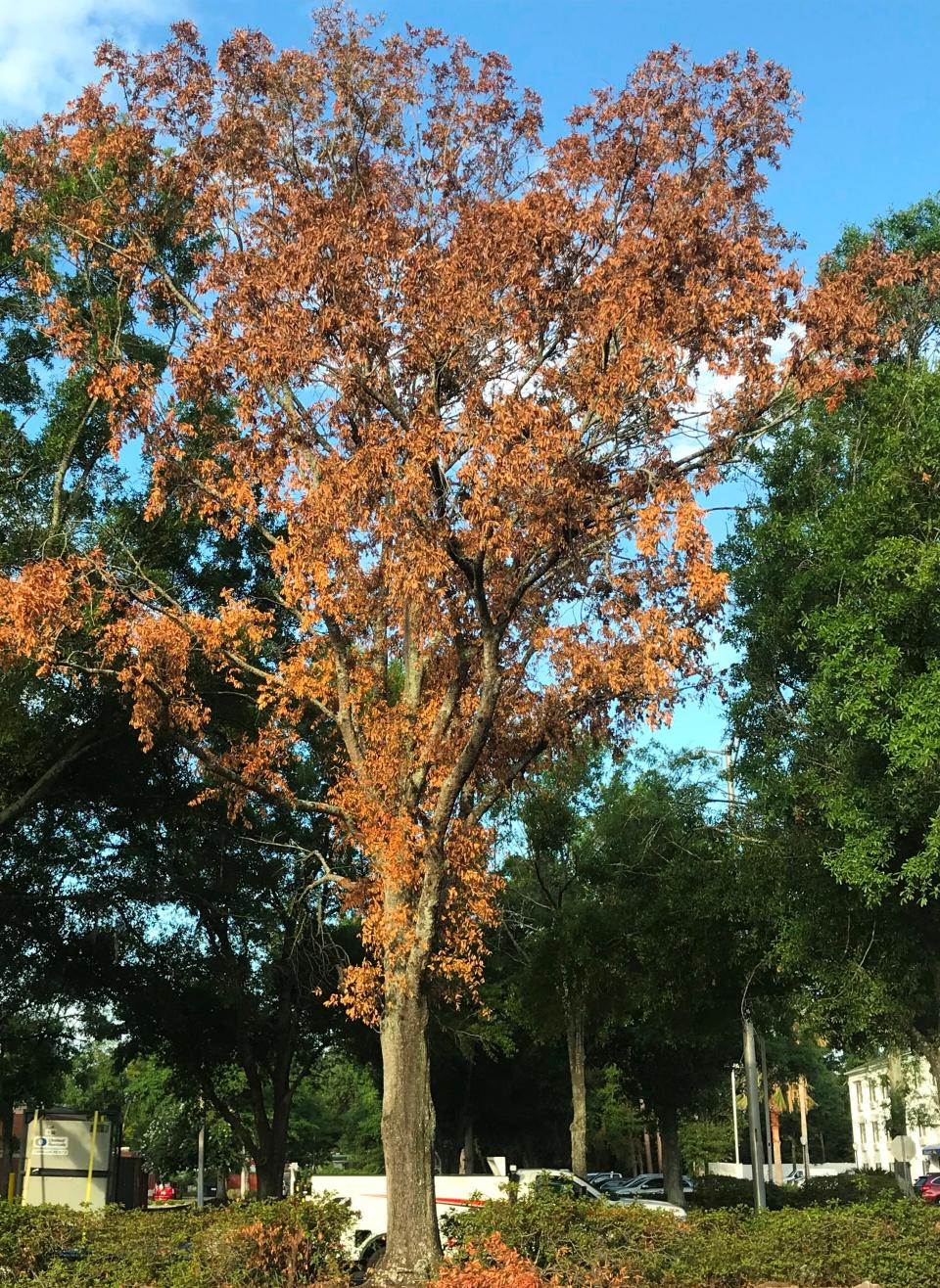How to tell if your tree is stressed — and what you can do about it

The last few months have been difficult for some trees. You can’t help but drive through any neighborhood and notice that some trees seemingly died overnight. Quite a few newly planted trees have died as well. While we have gotten a little bit of timely rainfall lately, some trees may not bounce back as readily.
The normal rainfall for April, May and the first three weeks of June is 10.5 inches. During the same time period this year, we only recorded around 5.9 inches of rain. That is only about 56 percent of what we would normally receive. The hotter and dryer than normal weather has caused many trees to become stressed. We do not think of having to provide supplemental irrigation to mature trees, but in certain cases, it may be warranted.
There are three primary reasons why trees are stressed this time of year: drought, heat and root disease. If you notice your tree not looking like it should, it may be from one or more of these issues.
More tree tips: Will your trees survive a hurricane's winds? What you should know about pruning and more
Garden Help: Low-maintenance fruit trees that work well in Northeast Florida
Drought: In Northeast Florida, we typically have a dry spell March through May but this year has been drier than normal. This is also the period where new leaves are also emerging creating a higher demand for soil moisture. Trees need water to perform many of their basic functions. For example, trees use carbon dioxide and water in combination with sunlight in photosynthesis. In other words, they use water to make their own food. If there is a shortage of water, the tree produces less food for itself. So, in other words, trees may be producing less food for themselves during hot dry weather.

Heat: If you have lived in Northeast Florida very long, you know that our summers are hot. In a typical summer, we have at least 10 days where the temperature exceeds 95 degrees. In plants, and our trees as well, hot temperatures can increase water loss through the leaves. The process by which water is evaporated through leaves is called transpiration.
Transpiration is why we feel much cooler under the shade of a large tree. It is estimated that a large shade tree will transpire 120 gallons of water a day during the summer. Trees are impacted when temperatures stay hot for long periods of time and cannot replace the water lost during transpiration. This water deficit is compounded when the soil is dry. If more water is lost through transpiration than the tree can absorb through its roots, it becomes drought-stressed. The roots cannot extract water from very dry soil. Periods of persistent stress cause rapid decline and death in trees.
Newly planted trees are especially vulnerable to hot and dry weather. They are used to receiving more than enough water in the nursery but when they get planted in the landscape, they are rarely watered enough. To properly irrigate a newly planted tree, it requires a dedicated water source. Typically, these include individual water emitters or water bags that need to be refilled often. Rarely do turf sprinkler systems provide enough irrigation for newly planted trees.
Root disease: Root disease is the factor that is common when larger older trees die suddenly. Root diseases are caused by fungi. Common root fungi are Armillaria and Ganoderma. Armillaria and Ganoderma are naturally occurring fungi that cause decay in wood. They are found in the soil and enter trees through root wounds. Frequently the root is wounded during some sort of activity of man. This can include lawnmower damage, roots cut during construction, or roots severed through utility installation. These root fungi can colonize the root system and persist in the tree unrecognized for years or decades in some cases. Bit by bit, year after year, the root fungi will compromise the trees’ ability to take up water. At some point, the tree root system is compromised where it cannot supply adequate moisture to the crown of the tree and the tree dies. This death can appear “sudden” during periods of high heat and drought. However, in most cases, trees colonized by root decay fungi often take months or years to die. Their foliage progressively becomes thinner and thinner with an increasing amount of branch dieback until it is obvious that the tree must be removed.
What should we do? While there is no solution for root disease, we may be able to give our trees some relief from the stress of hot and dry weather. Add an inch of water through irrigation to wet the top 12 inches of soil every week in an extended drought. Apply water to all soil under the canopy if possible. This may take several hours or more depending on what type of application devices are available to you. If you have limited time to devote to your trees, it is better to completely wet a small area than to only wet the surface a few inches over a large area. Limit pedestrian, mower, and vehicle traffic under the tree. Be sure you comply with local water restrictions which can limit the days and times when you can irrigate. Once the summer rainfall season kicks in you can start reducing the amount you are irrigating trees.
For more information on drought and trees go to: https://www.extension.purdue.edu/extmedia/fnr/fnr-483-w.pdf.
Larry Figart is an urban forestry extension agent with the University of Florida/IFAS.
This article originally appeared on Florida Times-Union: How do you know if a tree is stressed? Here are some answers.

